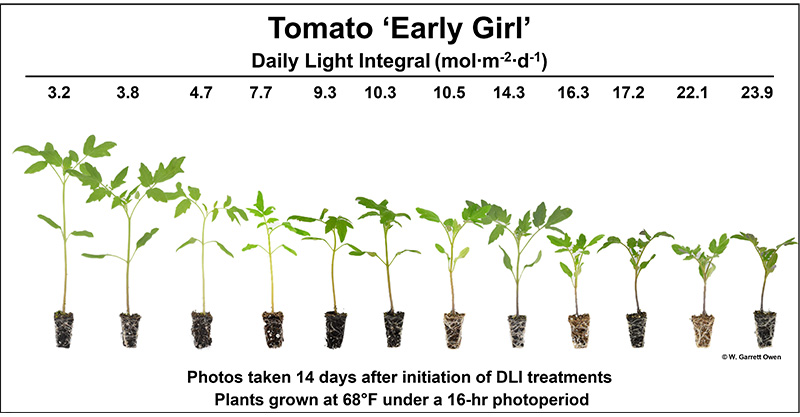
Increasing Daily Light Integral Improves Vegetable Transplant Quality
Vegetable transplants can be produced year-round for controlled-environment production; however, spring is the most popular season for greenhouse growers to produce vegetable transplants destined for retail garden centers and field production. During early-spring months, ambient outdoor daily light integrals (DLIs) can range from 5 to 25 mol·m–2·d–1 for most of the United States. Light transmission into the greenhouse can be reduced by 60% or more from the glazing material or shading from infrastructure, overhead equipment, and hanging baskets. Under low DLIs, germination will be uneven or delayed thus increasing production time. Furthermore, young transplants (plugs) will exhibit poor root growth with stretched, weak hypocotyls that can be easily broken while handling or transplanting. The optimal DLI range for vegetable transplant production is 10 to 15 mol·m–2·d–1. Maintaining an optimal DLI reduces production time and yields high-quality transplants that are compact with short, thick hypocotyls, smaller leaves, and are well rooted. Additionally, these transplants are less likely to be damaged when handled. To improve transplant quality and increase DLI under light limiting conditions, growers can implement a lighting strategy that manipulates light quantity (intensity) and duration (photoperiod) such as supplemental day-extension lighting. However, this may not be feasible for all. Keeping the glazing material clean, limiting overhead obstructions, retracting shade curtains, or removing whitewash or hanging baskets suspended above the transplants are some light management strategies that can increase light transmission into the propagation and/or growing environments.

W. Garrett Owen
Assistant Professor of Sustainable Greenhouse and Nursery Systems, The Ohio State UniversityW. Garrett Owen is an Assistant Professor of Sustainable Greenhouse and Nursery Systems in the Department of Horticulture and Crop Science at The Ohio State University. He has an appointment in research, teaching and Extension. His area of expertise is plant nutrition; plant growth regulation; and production problem diagnostics.
